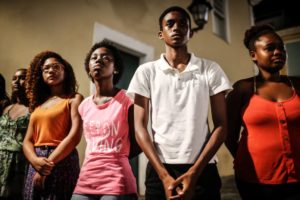
SALVADOR, BRAZIL -Social psychologist finds Black Brazilian children in interracial families face shocking racism. (Photo by Mario Tama/Getty Images)
“The most shocking story I heard was told by a young woman, a university student who came to see me… she was phenotypically ‘Black’ but her mother was ‘white.’ She told me that when she was little, her mother would sing a lullaby with these words: ‘Plantei uma cenoura no meu quintal / Nasceu uma negrinha de avental / Dança negrinha / Não sei dançar / Pega no chicote, ela dança já’ [I planted a carrot in my backyard. / It sprouted a nigger girl in an apron. / Dance, little nigger girl! / I can’t dance. / Show her the whip, she’ll dance alright.] Her mother’s lullaby wasn’t just racist, it was a slave owner’s song.” — Social psychologist Lia Vainer Schucman from a June 2017 interview with Agência FAPESP in Brazil
Perhaps you’ve heard of the ‘bleach bath,’ a popular process designed to significantly lighten one’s skin. Or maybe the clothespin, the laundry drying device that doubles as a nighttime nasal clamp to narrow the width of what is regarded as a phenotypically Black nose. Here in the 21st century, such tragic racialized practices and psychoses are, unfortunately, still alive and well in countries across the globe.
This acknowledged, there is a common perception that the more racially diverse and interracial a society and its relationships become, the less racism it will endure. It is a questionable line of reasoning particularly prevalent in Brazil where racially mixed societies and families are the norm. It fuels the popular national narrative that racial prejudice cannot exist in South America’s largest country since “somos todos iguais” (“we are all equal”).
A recent study by social psychologist and researcher Lia Vainer Schucman says otherwise. In it, Schucman interviewed interracial families from regions across Brazil willing to discuss the manifestations and impact of racism within their units as part of her postdoctoral work at the University of São Paulo. Sponsored by Agência FAPESP, a media service of the São Paulo Research Foundation, Schucman’s research is the subject of her upcoming book, “Famílias Inter-Raciais: Tensões entre Cor e Amor” (Inter-Racial Families: Tensions Between Color and Love).
“With the rare exceptions of families that acquire racial consciousness or who are activists in the Black movement, the desire for whitening is a Brazilian ideology that ends up being internalized within interracial families,” says Schucman. “The testimonies of the subjects interviewed are shocking with horrible memories where the child relates the suffering of having to obligatorily straighten their hair or take baths with bleach in an attempt to be whiter.” These stories, she explains, “illustrate how this sophisticated mechanism of negation appears to be the key to understanding the central question of Brazilian society.” That being, “How can a country with an accepted and observable racial mixture be, at the same time, a place where the highest indications of racism in the world are perpetuated?”
It certainly comes as no surprise to Black people that racism pervades in a racially heterogeneous country like Brazil where roughly 112 million Afro-Brazilians make up over half the population. It is the world’s largest Black population outside of Africa and second only to Nigeria. The United Nations Children’s Fund has reported Black Brazilians ages 12 to 18 are three times more likely to get killed than their white counterparts, and a study by the University of São Carlos revealed Afro-Brazilians are more likely to be killed by military police and make up 62 percent of those incarcerated nationwide.
Given this stark reality, racial prejudice within the same Brazilian family just shows how deep such a loaded social construct goes. It is an unfortunate reflection of the society at large and how its relationships, interracial or otherwise, are imbued with its ills, biases and indoctrinations.
“Speaking about color, race and racism within a nuclear family is always very tense precisely because it presupposes in a romanticized form that, within families, there is ‘unconditional love,’” says Schucman. “This impedes one to speak openly about how the structural hierarchies of our society are also reproduced and legitimated within families.”
Unlike America where origin substantially contributes to racial classification, she says, “Here, we have a structural racism characterized by the ideology of whitening where skin color or phenotype is what determines if someone is white or Black.” Therefore, “We have children of interracial marriages where one brother or sister may be socially read as Black and the other as white. In this sense, typical Brazilian racism makes many families hope at the time of pregnancy that their children will be born fair-skinned.”
The victims of such social psychosis know this type of racial reasoning all too well.
“I have said this a thousand times,” recently posted the unnamed lead blogger for Black Women of Brazil, a website dedicated to Brazilian women of African descent. “Under a system of white supremacy, integration and interracial relationships don’t solve the problem. People will simply uphold and declare their value systems that posits white people, whiteness and European physical features on top of the racial hierarchy.”
It was designed this way. Beginning in the 15th century, the Portuguese captured, enslaved and exported five million Africans to Brazil to toil in its sugarcane plantations and, later on, in its lucrative gold and diamond mines. As these industries grew, the number of enslaved Africans did as well and by the time slavery was finally outlawed due to mass rebellion in 1888 — the last country to end the heinous institution — masses of Africans were upon Brazilian soil. From this new reality, a multiracial underclass emerged where poor whites and the formerly enslaved resided together in poverty-stricken slums or favelas.
At the time — owing to the threatening numbers of the country’s darker inhabitants, a desire to exclude them as paid laborers and an effort to preserve whiteness in the population — a national campaign was waged to recruit European peasants to Brazil as wage workers. In 1890, Decree #528 was signed by President Diodorus da Fonseca prohibiting the entry of immigrants from Africa and Asia while encouraging the immigration of Europeans. The decree further created a policy known as branqueamento, aimed at ‘whitening’ and ‘civilizing’ the Brazilian population.
In the 1930s, popular intellectual Gilberto Freyre offered his own contribution to the race problem in the form of his seminal book, “Casa-Grande e Senzala” (The Big House and the Slave Quarters), which revised the inhuman institutional history of Brazilian slavery by casting the Portuguese as kind, gentle masters. Freyre’s idea, given the unrelenting number of Afro-Brazilians and the white establishment’s fear of being overthrown, was to convert the mixing of races into a virtue and begin touting Brazil as a “racial democracy.” Doing so, he figured, would work to appease the Afro-Brazilian masses while masking racism and maintaining the country’s racial hierarchy with whiteness on top. Simultaneously, Freyre worked hand in hand with populist dictator Getúlio Vargas and his Estado Novo or ‘new state’ policies designed to promote and embed branqueamento for generations to come. Or as writer Achal Prabhala once put it, “The battered body of slave culture was abducted by national culture in order to renew white culture.”
Schucman adds yet another layer to Brazil’s unique development of racial denial. “I believe that one of the reasons people deny the existence of racism is because they believe racism necessarily means segregation,” she offers, noting the popular international affiliation of the term with Jim Crow-era America and apartheid in South Africa. “In Brazil, racism does not stop proximity between individuals or people having loving relationships, however, these are hierarchical, asymmetrical and unequal relationships. Because white and Black people can go to the same places, it induces the thought there is an ideal racial harmony, which is fallacious.”
The way to begin correcting such falsehoods, believes Schucman, is to recognize the connection between race and social inequity and demand applicable “policies such as income transfer or distributive practices.” Given a misguided “War on Drugs” and the genocide of Black people at the hands of police, she further insists, “We have to fight for the demilitarization of our police and the legalization of drugs. Finally, there is the symbolic dimension of representation which needs to be addressed both by education and media,” one steeped in structural racism and in need of collective action by “society as a whole.”
But whether or not Brazil can rectify its entrenched issues with racism, Schucman’s work recognizes individuals within color-conscious Brazilian families who strive to reconcile their own racial identities despite the pain such an externally imposed struggle can bring. In her Agência FAPESP interview, Schucman revealed the plight of the Black girl with the white mother who sang her racist lullabies and how she later went to college, began psychotherapy, learned more about African culture and even became involved in a Black social movement.
Still, the indelible impact of her mother’s actions was apparent.
“She told me there were two people inside her,” reported Schucman, one who “participated in the movement and was an activist and proud of her frizzy hair. The other was still that outrageously ill-treated child. She said she firmly believed she would find redemption one day, but until then, that child remained in her.
“And it hurt.”


